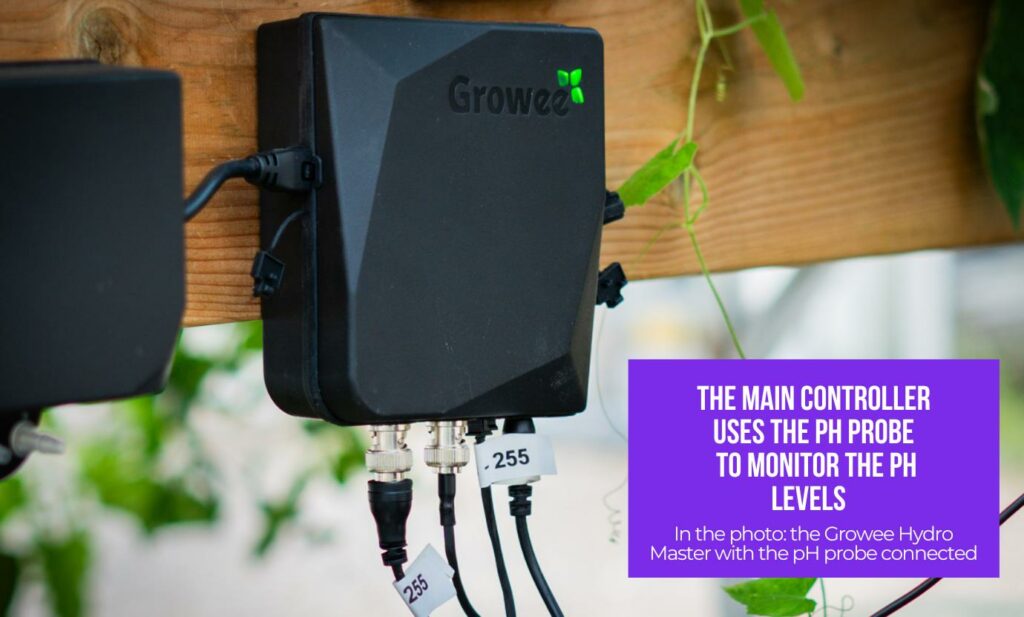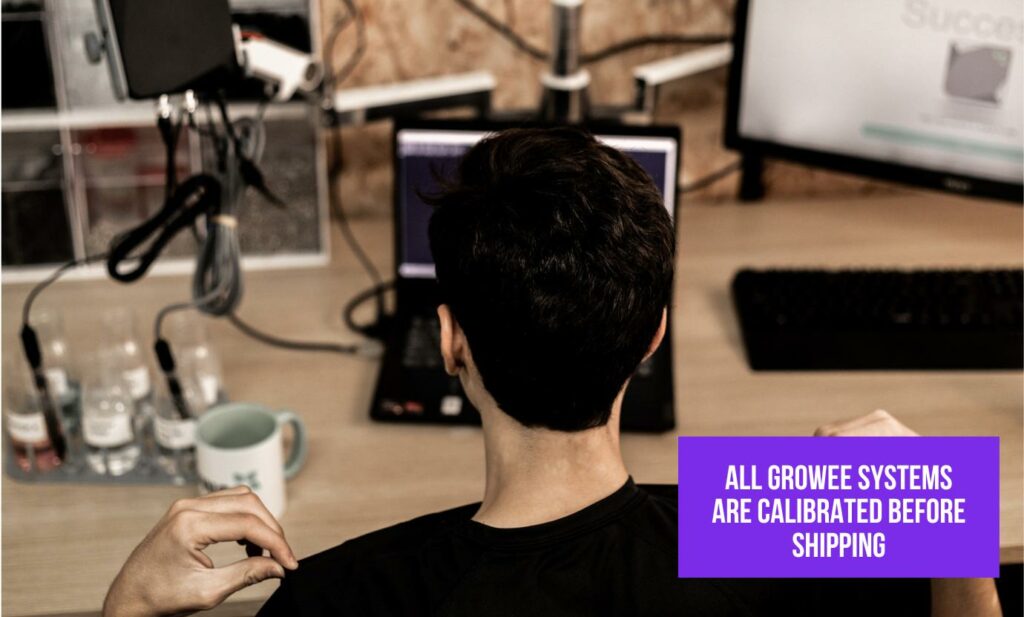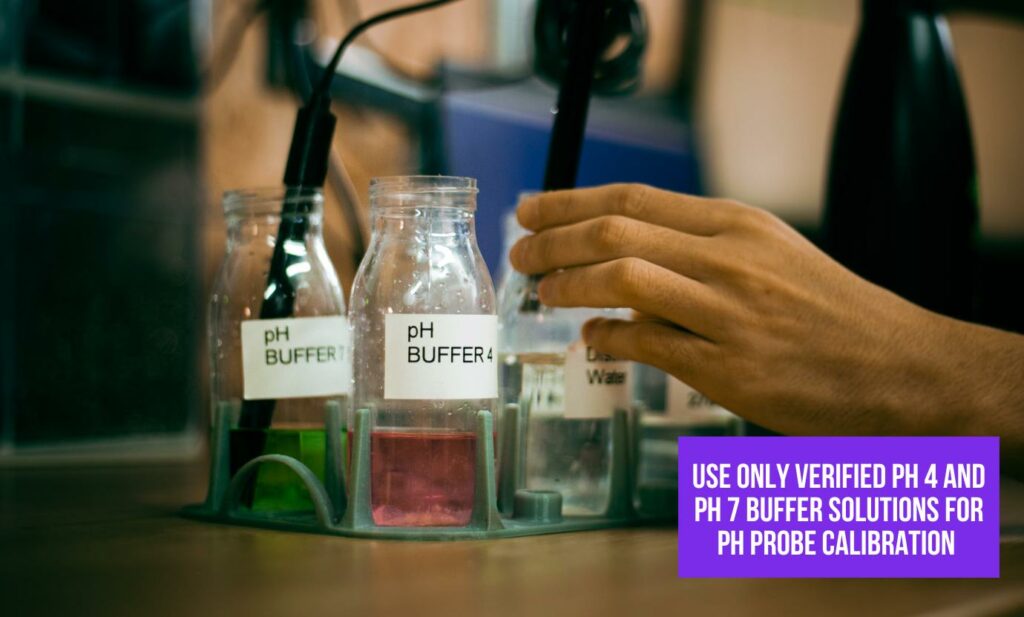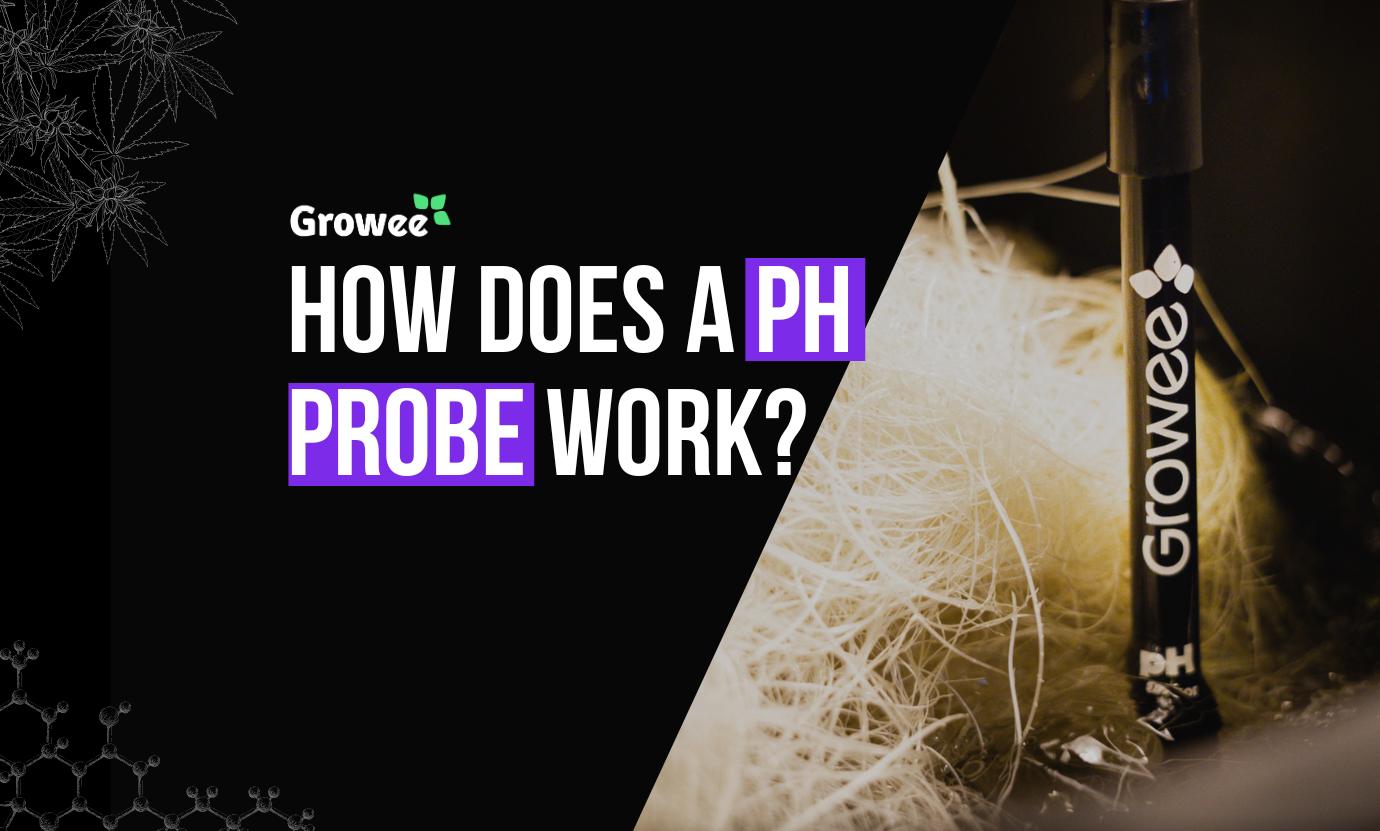What is a pH Probe?
A pH probe is a scientific instrument used to measure the acidity or alkalinity of a solution by measuring the hydrogen-ion activity in water-based solutions. It consists of a glass electrode, a reference electrode, and a pH meter that displays the pH reading. The probe is often encased in a plastic or glass body to protect its sensitive components.
In the case of the Growee hydroponics control system, the pH probe is connected to the Hydro Master, the main Wi-Fi connected controller.
See How Growee Can Save You Time By Automating Your Plants Feeding
Water pH – Automated pH Up and Down Control
Nutrients Mixing – Automated Nutrient Dosing with Target EC / PPM Control.
Control From Anywhere – WiFi Connection and mobile App
What is Hydrogen-Ion Activity?
Hydrogen-ion activity refers to the concentration of hydrogen ions (H+) in a solution. These ions determine whether a solution is acidic or basic (alkaline). In simple terms, more hydrogen ions mean a solution is more acidic, while fewer hydrogen ions mean it is more basic.
How pH Measures Hydrogen-Ion Activity?
The pH scale is a way to measure the acidity or alkalinity of a solution, ranging from 0 to 14. A pH of 7 is neutral, meaning the solution is neither acidic nor basic. Numbers below 7 indicate acidity, and numbers above 7 indicate alkalinity.
- Acidic Solution (pH < 7): High concentration of hydrogen ions.
- Neutral Solution (pH = 7): Balanced concentration of hydrogen and hydroxide ions.
- Basic Solution (pH > 7): Low concentration of hydrogen ions.
A pH probe measures the hydrogen-ion activity in a solution through its glass electrode and reference electrode.
- Glass Electrode: The tip of the pH probe contains a special glass bulb filled with a known concentration of hydrogen ions. When this glass bulb is immersed in a solution, hydrogen ions in the solution interact with the ions in the glass bulb.
- Reference Electrode: The probe also has a reference electrode filled with a stable electrolyte solution, usually potassium chloride (KCl). This reference electrode provides a constant comparison point.
- Voltage Difference: The interaction between hydrogen ions in the solution and those in the glass bulb creates a tiny voltage (electrical potential difference). This voltage changes depending on the hydrogen-ion concentration in the solution.
- pH Meter: The pH meter connected to the probe measures this voltage difference and converts it into a pH value, which is displayed on the screen.
Hydroponics pH Controllers and pH Probes
In systems like Growee, the pH probe is connected to the main hydroponics controller, known as the Hydro Master. The Hydro Master monitors the pH levels in real-time and can automatically adjust the pH by adding pH up or pH down solutions, using the Growee pH Balacner,ensuring that the nutrient solution remains within the optimal pH range for plant growth.

The Role of The Bulb and The Internal Liquid
The glass electrode has a bulb at its end, which contains a thin layer of the special glass membrane. Inside the bulb, there is a small amount of electrolyte solution, usually a buffered solution of known pH. This internal solution allows for the transfer of ions between the glass membrane and the reference electrode.
What is a Double Junction pH Probe?
A double junction pH probe features an additional reference junction, which provides extra protection against contamination and reference fouling. In a double junction probe, the reference electrode has two chambers: one filled with the standard electrolyte solution and the other filled with an additional electrolyte solution.
This design helps to prevent contaminants from the solution being tested from entering the reference electrode and affecting the pH readings.
Why a pH Probe is More Delicate Than an EC Probe?
1. Sensitivity of Glass Electrode
The primary reason a pH probe is more delic
ate than an EC (electrical conductivity) probe lies in its glass electrode. The glass membrane is designed to be highly sensitive to hydrogen ions (H+), allowing it to accurately measure the pH of a solution. This sensitivity makes the glass membrane more fragile and prone to damage from physical impacts or exposure to harsh chemicals.
2. Chemical Composition
pH probes contain a specific electrolyte solution inside the glass bulb and often have a more complex chemical environment. Any contamination or loss of this solution can significantly impact the accuracy and functionality of the probe. In contrast, EC probes typically have a more robust construction with metal electrodes that measure the electrical conductivity of the solution, making them less susceptible to damage and contamination.
3. Reference Junction
pH probes have a reference junction that can become clogged or contaminated over time, especially when exposed to substances that can precipitate out or react with the electrolyte solution. This clogging can affect the accuracy of pH measurements and is a more common issue than in EC probes, which do not have such a junction.
Importance of Maintaining a pH Probe
1. Accuracy of Measurements
Proper maintenance ensures the pH probe remains accurate. An unmaintained pH probe can give erroneous readings, which can lead to incorrect pH adjustments in your hydroponic system, potentially harming plant health.
2. Prolonging Lifespan
Regular maintenance can help prolong the lifespan of a pH probe by preventing issues like clogging of the reference junction and degradation of the glass electrode.
How to Maintain a pH Probe?
1. Regular Calibration
Calibrate your pH probe regularly, minimum every grow cycle using standard pH 4 and 7 solutions. This ensures that the probe provides accurate readings.
2. Proper Storage
Store the pH probe in a storage solution when not in use. This prevents the glass membrane from drying out and maintains the internal electrolyte solution. Never store the probe in distilled or deionized water, as this can damage the electrode and avoid keeping the probe dry.
3. Cleaning the pH Probe
Clean the pH probe regularly to remove any build-up of deposits or contaminants. Use a pH probe cleaning solution specifically designed for this purpose. You can clean most probes with a gentle tooth brush under running water.
4. Avoiding Physical Damage to the pH Probe Electrode
Handle the pH probe with care to avoid physical damage to the glass electrode. Avoid knocking the probe against hard surfaces or exposing it to extreme temperatures.
Most cases of pH probe bulbs or electrodes breaking are due to the grower dropping them.
Always handle the probe gently and ensure it is securely placed in a holder or storage container when not in use to prevent accidental damage.
How to Calibrate The Growee pH Probe?
Calibration is an electric match between the probe and the meter or control system, which ensures that the readings are accurate and consistent.

This is why when changing a probe, it needs to be calibrated to the new system. Calibrating a pH probe is essential to ensure accurate pH measurements in your hydroponic system.
All Growee systems are calibrated before shipping, but if you need to change your probe and calibrate to the Hydro Master, Here’s a step-by-step guide to calibrate your pH probe:
Materials Needed:
- Growee Hydro Master Connecet to the internet
- Growee Mobile App
- pH Probe connect to the Hydro Master
- pH Calibration solutions pH 4.0 and pH 7.0.
- Clean container
- Soft tissue or cloth
- RO or disstield water for washing the probes between solutions
Step-by-Step Calibration Process:
- Wash and Dry the pH Probe: Place it inside the pH 7 solution for 2-3 minutes. It is important to see the reading on the Growee App, which will provide a reference for how far you are from calibrating the probe, as it should show 7.0.
- Start the pH 7 Calibration Process on the Growee App: On the Growee App, go to Modify > pH Balance, press the pH calibration button, and start the pH 7 calibration step until it is done. After that, wash and dry the probe.
- The pH 4 Calibration Stage on the Growee App: Place the probe inside the pH 4 solution for 2-3 minutes, and wait for stabilization. Start the pH 4 calibration step until it is done.
- Verify Calibration: Place the probe inside the pH 7 solution and wait 2-3 minutes. The reading should be in the range of +/- 0.1, meaning between 6.9 – 7.1. Do the same for the pH 4 solution; it should be between 3.9 – 4.1.

Conclusion
Regular and accurate calibration of your pH probe is crucial for maintaining the health of your hydroponic system. By following these steps, you can ensure your pH readings are precise, helping you to maintain the optimal growing conditions for your plants.
FAQ
How does a pH probe work?
A pH probe measures the hydrogen-ion activity in a solution through its glass electrode and reference electrode. The glass electrode interacts with hydrogen ions in the solution, creating a voltage difference that the pH meter converts into a pH value.
Why is it important to calibrate a pH probe?
Calibration ensures that the pH probe provides accurate and consistent readings. It matches the probe to the meter or control system, which is essential when changing probes or for regular maintenance.
How often should I calibrate my pH probe?
It’s recommended to calibrate your pH probe regularly, at least every grow cycle, using standard pH 4 and 7 solutions. Regular calibration maintains the accuracy of the readings.
Can I store my pH probe in distilled water?
No, you should never store a pH probe in distilled or deionized water as it can damage the electrode. Always store it in a storage solution designed for pH probes.
What is a double junction pH probe?
A double junction pH probe features an additional reference junction, providing extra protection against contamination and reference fouling. This design helps to maintain accurate pH readings by preventing contaminants from entering the reference electrode.
What is the difference between measuring water pH and soil pH?
Measuring water pH involves immersing a pH probe directly into the liquid, providing an immediate reading. Measuring soil pH usually requires creating a soil slurry with distilled water and then using a soil pH meter to read the pH of the slurry. Some advanced soil pH meters can measure directly in the soil without creating a slurry.



